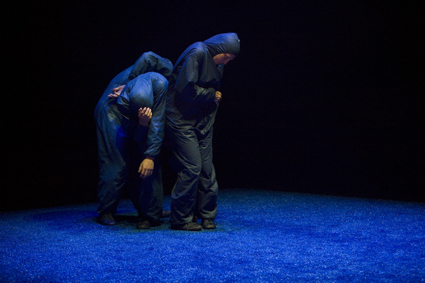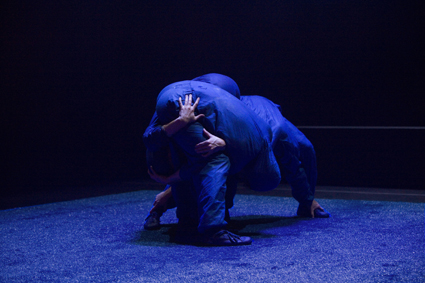a not so private hearing
carl nilsson-polias: tim darbyshire, more or less concrete

More or Less Concrete, Tim Darbyshire
photo Ponch Hawkes
More or Less Concrete, Tim Darbyshire
THE TITLE MORE OR LESS CONCRETE MIGHT AS WELL BE A CONCISE PERSONALITY TEST OF THE HALF-GLASS VARIETY. ARE YOU A MORE CONCRETE PERSON? OR A LESS CONCRETE PERSON? OR ARE YOU MORE OR LESS A CONCRETE PERSON?
Do you look for concrete meaning, narrative and figuration in Tim Darbyshire’s creation? Or do you look instead between the figuration to the abstractions, reveries and enigmas? You might find yourself pondering such questions as you take off your headphones at the end of More or Less Concrete.
Yes, you get headphones. For a production presented with a fairly standard end-on seating bank and a letterbox proscenium arch it seems an odd choice. The sound design itself rarely makes specific use of the medium in terms of aural quality, apart from at the very beginning, when a brilliant rendering of a muffled conversation between a man and a woman seems real enough for one to question the soundproofing of the North Melbourne Town Hall. Apart from that, the sound itself is not so quiet, nor so delicate that one needs headphones to discern it.
What the headphones largely achieve is to personalise and internalise the audio. On the one hand, there is the physical reality that no one else is hearing what’s on your headphones. On the other hand, there is the paranoia that someone else’s headphones are getting better sound. Looking at rows of audience members in front of you, it becomes impossible not to feel distanced from them by this technological interference and perhaps the ubiquity of headphones in public spaces has rendered them a visual liability as much as an aural utility. This personalising aspect is compounded by the way our brains process information from headphones. We can perceive depth, location and movement using only our ears. When we move our heads, the sound signals alter slightly and this gives us even clearer metrics on where the sound is coming from. Headphones, by not changing the sound signals when we move our heads, cancel our depth perception. Our brain decides that the sound cannot be external and collapses the sound image into our head.

More or Less Concrete, Tim Darbyshire
photo Ponch Hawkes
More or Less Concrete, Tim Darbyshire
For a work like More or Less Concrete, this internalisation of the audio is a potential boon. So much of what Darbyshire seems to be striving for here is a liminal space between humour and melancholy, between the concrete and the abstract. The internalising aspects of the headphones can engender the pensive questioning of ambiguity required, they beg for subjective wandering. Yet, Darbyshire and his collaborators have not fully capitalised on their decision. The sound design largely remains within the literal diegetic sphere of amplified sounds from the stage relayed in real time. These sounds themselves are often literal in their choreographic derivation: the dancers move their arms as though being inflated and make sounds of inflation, the dancers move like animals and growl appropriately, a dancer bites an apple and we hear the crunch of an apple. Musique concrète is cited as an inspiration but there is only very occasionally the kind of collage, musicality and poetry that Pierre Schaeffer and his acolytes brought to that form. When the sound and the movement do contrast, both are made more profound, more expansive and mysterious. We are given room to imagine, to set our minds adrift in this non-literal space and the piece lifts accordingly. In other words, I wanted less concrete and more concrète.
Visually, More or Less Concrete can be seen as an evolutionary bildungsroman in blue. It begins with a distant body, an indiscernible blue clay that writhes slowly until it ejects one human form, then another and another. Their bodies are heavy, weighed down by the primordial soup, leaving only their backsides to float upwards. They find breath, they find limbs, they find extension. Bit by bit, they approach us, mounting one obstacle after another though they can barely stand. As they emerge finally beyond the proscenium, the house lights rise to meet them but their eyes are closed like moles, like newborns. It is all too much for them. Not 45 minutes ago they were still sparks in Prometheus’ eye. Now, they retreat slowly into the gloom far away.
But through our headphones we still hear their echo in our heads. Sound travels slower than light.
–
Dance Massive: Arts House & Tim Darbyshire: More or Less Concrete, choreographer Tim Darbyshire, performers: Sophia Cowen, Tim Darbyshire, Josh Mu, sound Design Jem Savage, lighting Ben (Bosco) Shaw, Bluebottle, dramaturge, sound theorist Thembi Soddell, costumes Rebecca Agnew, Arts House, North Melbourne Town Hall, March 20-24; http://dancemassive.com.au/
See also Keith Gallasch’s review and the realtime tv interview with Tim Darbyshire






